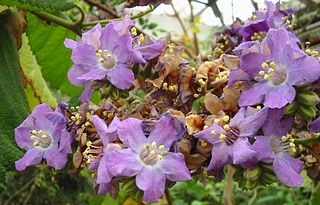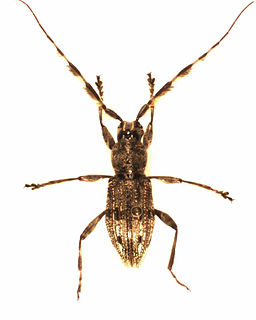Ayapana ecuadorensis is a species of flowering plant in the family Asteraceae. It is found only in Ecuador. Its natural habitat is subtropical or tropical moist lowland forests. It is threatened by habitat loss.
Phalacraea ecuadorensis is a species of flowering plant in the family Asteraceae. It is found only in Ecuador. Its natural habitat is subtropical or tropical moist montane forests. It is threatened by habitat loss.
Salvia ecuadorensis is a species of flowering plant in the family Lamiaceae that is native to Ecuador. Its natural habitat is subtropical or tropical moist montane forests.
Annona ecuadorensis is a species of plant in the Annonaceae family. It is endemic to Ecuador. Its natural habitat is subtropical or tropical moist lowland forests. It is threatened by habitat loss.
Castilleja ecuadorensis is a species of plant in the family Orobanchaceae. It is endemic to Ecuador.
Geissanthus ecuadorensis is a species of tree in the family Primulaceae. It is native to Ecuador and Peru. G. ecuadorensis is considered a vulnerable species by the IUCN.
Guatteria ecuadorensis is a species of plant in the Annonaceae family. It is endemic to Ecuador. Its natural habitat is subtropical or tropical moist lowland forests. It is threatened by habitat loss.
Guzmania ecuadorensis is a species of plant in the family Bromeliaceae. It is endemic to Ecuador. Its natural habitats are subtropical or tropical moist montane forests and subtropical or tropical high-altitude shrubland. It is threatened by habitat loss.
Chalybea ecuadorensis is a species of plant in the family Melastomataceae. It is endemic to Ecuador. Its natural habitat is subtropical or tropical moist montane forests.
Matelea ecuadorensis is a species of plant in the family Apocynaceae. It is endemic to Ecuador. Its natural habitat is subtropical or tropical moist montane forests. It is threatened by habitat loss.
Monopyle ecuadorensis is a species of plant in the family Gesneriaceae. It is endemic to Ecuador. Its natural habitats are subtropical or tropical moist lowland forests and subtropical or tropical moist montane forests.
Napeanthus ecuadorensis is a species of plant in the family Gesneriaceae. It is endemic to Ecuador. Its natural habitat is subtropical or tropical moist montane forests.
Oreopanax ecuadorensis is a species of plant in the family Araliaceae. It is endemic to Ecuador. Its natural habitats are subtropical or tropical moist montane forests and subtropical or tropical high-altitude shrubland. It is threatened by habitat loss.
Oxalis ecuadorensis is a species of plant in the family Oxalidaceae. It is endemic to Ecuador.
Uncinia ecuadorensis is a species of plant in the sedge family, Cyperaceae. It is endemic to Ecuador. Its natural habitat is subtropical or tropical high-altitude grassland.
Vallea ecuadorensis is a species of tree in the Elaeocarpaceae family. Although formerly considered endemic to Ecuador it has also been collected in Bolivia and Peru. This species occurs in subtropical or tropical moist montane forests, at 2500 – 3500 meters above sea level.

Wigandia is a genus of flowering plants within the waterleaf subfamily, Hydrophylloideae. They are found mainly in Central America and South America, though one or two species are found as far north as the United States. Some are grown as ornamental plants and will flourish in most Mediterranean or temperate regions. The genus is named for Johann Wigand, German Lutheran cleric and theologian, and Bishop of Pomesania.

Cucurbita ecuadorensis is a species of squash, discovered in 1965 growing wild in Ecuador. Like most wild gourds and squashes, it is creeping vine and is often found climbing over other vegetation. It has been found only in the western provinces of Guayas and Manabi. There is evidence that it was domesticated in Ecuador around 10,000 years ago, likely for its seeds, but no direct records exist and it is no longer cultivated. It is resistant to many diseases of cultivated Cucurbita species, and has been used to breed resistance to several diseases into common squashes. For example, researchers at Cornell University used Cucurbita ecuadorensis to breed resistance to papaya ringspot virus, watermelon mosaic virus, and powdery mildew, into common Cucurbita maxima cultivars. Cucurbita ecuadorensis is listed on the IUCN Red List as vulnerable, and is found protected in the Machalilla National Park.

Parmenini is a tribe of longhorn beetles of the subfamily Lamiinae.
Synotaxus is a genus of araneomorph spiders in the family Synotaxidae that was first described by Eugène Louis Simon in 1895. Originally placed with the tangle web spiders, it was moved to the Synotaxidae in 2017.


